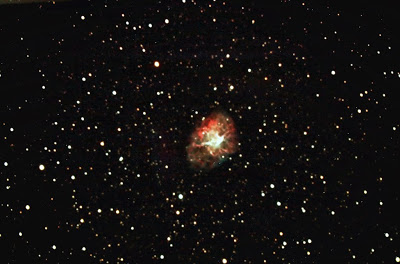Astronomy

- The Christmas Tree And The Cone Nebula - Ngc2264
The Christmas Tree Nebula (upside down) including the Cone Nebula at the bottom is in constallation Monoceros. The top of the Cone Nebula has a bright star forming the christmas tree top. The bright bluee and red nebula in the middle of tht picture...
- The Rosette Nebula In Monoceros In Ha
The Rosette Nebula with NGC 2244 star cluster in its middle is beautiful. The mass of the nebula is estimated to be around 10,000 solar masses. The cluster and nebula lie at a distance of some 5,200 LY from Earth and measure roughly 130 LY in diameter....
- The Flame Nebula And The Horsehead Nebula
The Flame Nebula (NGC2024) and The Horsehead Nebula (Bernard33) sticking its head out of the red glowing Nebula IC434. In the constellation Orion.The blue reflection nebula between the Horsehead and Flame nebula is NGC2024.Celestron 80ED - 600 mm, f7.5...
- The Pelican Nebula, Ic5067 And Ic 5070
The Pelican Nebula, IC5067 and IC5070, in the constallation Cygnus. With some imagination you can resemble a pleican in the red nebula. 1800 LY away from us. Celestron 80ED, 600 mm f7.5, piggyback on CPC11, 6x10 min ISO1600 with Canon 40D modified....
- The Crab Nebula.
The Crab Nebula in Taurus was first seen in 1024 by the Chineese and Arabs. The supernove explosion 6500 LY away in our Milky Way was visible to the naked eye in daylight for almost a month and in the night sky for almost two years. The remaining nebula...
Astronomy
The Crab Nebula, Messier1 using Ha and Oiii

The nebula was first observed by John Bevis in 1731, and corresponds to a bright supernova recorded by Chinese and Arab astronomers in 1054. About 6500 LY from us and 11 LY across. It is called the Crab Nebula here imaged in a Ha, Oiii and RGB sandwich. CPC11, 2000 mm with f 6,3. About 3 hours exposure time, 130 min Ha, 20 min Oiii, 40 min RGB, ISO1600. Camera Canon 40 D modified, guided, darks, flats.
- The Christmas Tree And The Cone Nebula - Ngc2264
The Christmas Tree Nebula (upside down) including the Cone Nebula at the bottom is in constallation Monoceros. The top of the Cone Nebula has a bright star forming the christmas tree top. The bright bluee and red nebula in the middle of tht picture...
- The Rosette Nebula In Monoceros In Ha
The Rosette Nebula with NGC 2244 star cluster in its middle is beautiful. The mass of the nebula is estimated to be around 10,000 solar masses. The cluster and nebula lie at a distance of some 5,200 LY from Earth and measure roughly 130 LY in diameter....
- The Flame Nebula And The Horsehead Nebula
The Flame Nebula (NGC2024) and The Horsehead Nebula (Bernard33) sticking its head out of the red glowing Nebula IC434. In the constellation Orion.The blue reflection nebula between the Horsehead and Flame nebula is NGC2024.Celestron 80ED - 600 mm, f7.5...
- The Pelican Nebula, Ic5067 And Ic 5070
The Pelican Nebula, IC5067 and IC5070, in the constallation Cygnus. With some imagination you can resemble a pleican in the red nebula. 1800 LY away from us. Celestron 80ED, 600 mm f7.5, piggyback on CPC11, 6x10 min ISO1600 with Canon 40D modified....
- The Crab Nebula.
The Crab Nebula in Taurus was first seen in 1024 by the Chineese and Arabs. The supernove explosion 6500 LY away in our Milky Way was visible to the naked eye in daylight for almost a month and in the night sky for almost two years. The remaining nebula...
